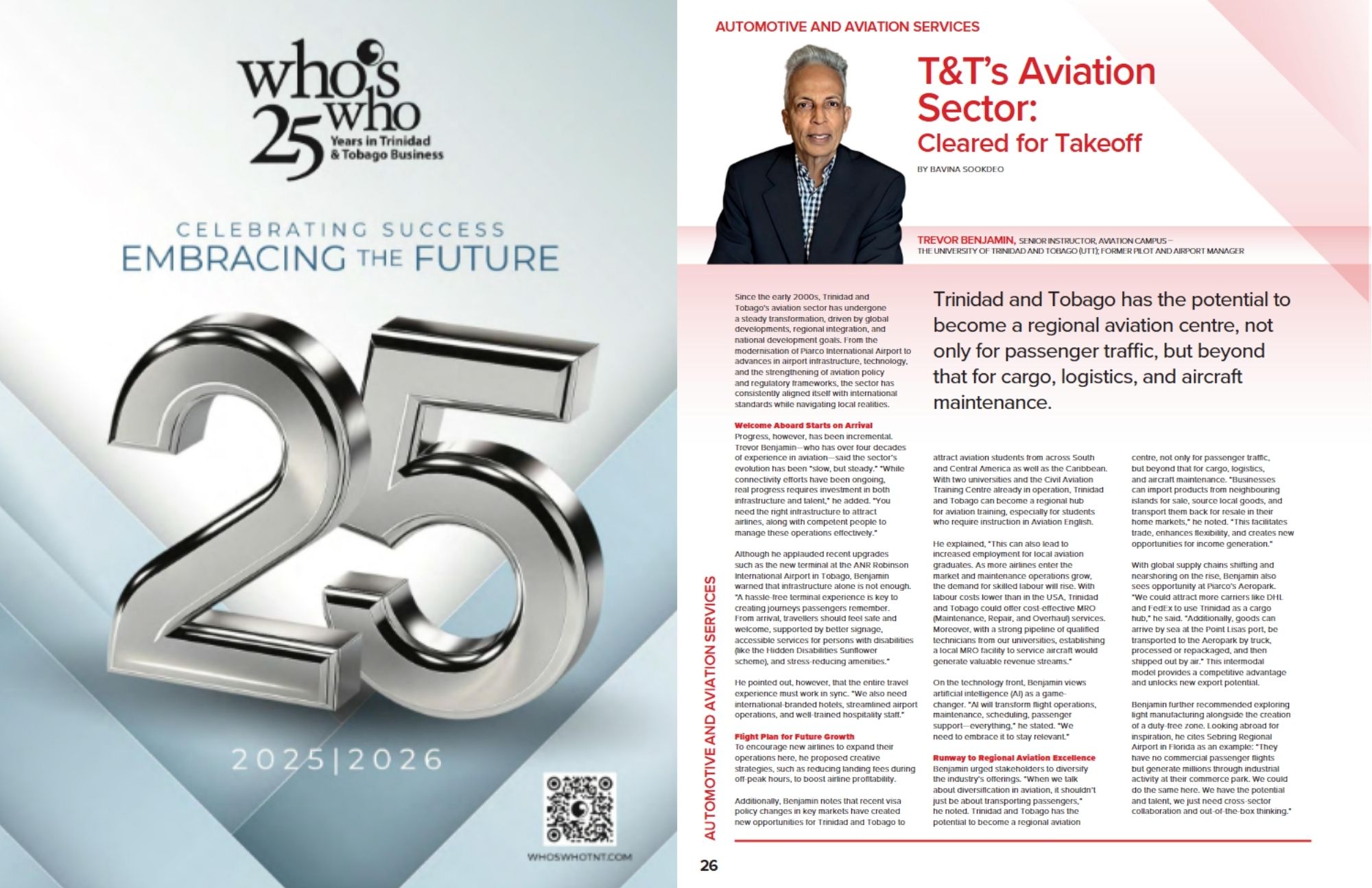
Trinidad & Tobago's Aviation Sector: Cleared for Takeoff
Since the early 2000s, Trinidad & Tobago's aviation sector has undergone a steady transformation driven by global developments, regional integration, and national development goals. From the modernization of Piarco International Airport to advances in airport infrastructure, technology, and the strengthening of aviation policy and regulatory frameworks, the sector has consistently aligned itself with international standards while navigating local realities.
Welcome Aboard Starts on Arrival
Progress, however, has been incremental. Trevor Benjamin—who has over four decades of experience in aviation—said the sector's evolution has been "slow but steady." "While connectivity efforts have been ongoing and real progress requires investment in both infrastructure and talent," he added. "You need the right infrastructure to attract airlines, along with competent people to manage these operations effectively."
Although he applauded recent upgrades such as the new terminal at the ANR Robinson International Airport in Tobago, Benjamin warned that infrastructure alone is not enough. A hassle free terminal experience is key to creating journey’s passengers remember. From arrival, travelers should feel safe and welcome, supported by better signage accessible services for persons with disabilities like the hidden disabilities, sunflower scheme, and stress, reducing amenities.
He pointed out, however, that the entire travel experience must work in sync. We also need international branded, hotels, streamlined airport operations, and well trained hospitality staff.
Flight plan for future growth
To encourage new airlines to expand their operations here, he proposed creative strategies such as reducing landing fees during off peak hours to boost airline profitability.
Additionally, Benjamin notes that recent visa policy changes in key markets have created new opportunities for Trinidad and Tobago. Two attract aviation students from across South and Central America, as well as the Caribbean. With two universities and the civil aviation training center already in operation, Trinidad and Tobago can become a regional hub for aviation training, especially for students who require instruction in aviation English.
He explained, “This can also lead to increased employment for local aviation graduates. As more airlines enter the market and maintenance operations grow, the demand for skilled labor will rise, with labor costs lower than in the USA. Trinidad and Tobago could offer cost-effective MRO.(maintenance, repair, and overhaul) services. Moreover, with a strong pipeline of qualified technicians from our universities, establishing a local MRO facility to service aircraft can generate valuable revenue streams.
On the technology front, Benjamin views Artificial Intelligence (AI) as a game-changer.“ AI will transform flight operations, maintenance, scheduling, passenger support—everything,” he said. “We need to embrace it to stay relevant.”
Runway to regional aviation excellence
Benjamin urged stakeholders to diversify the industry's offerings. “When we talk about diversification in aviation, it shouldn’t be just about transporting passengers,” he noted. Trinidad and Tobago has the potential to become a regional aviation center., not only for passenger traffic, but beyond that for cargo logistics and aircraft maintenance. “ bu businesses can import products from neighboring islands for sale, source, local goods, and transport them back for resale in their home markets,” he noted. “ this facilitates trade, enhances flexibility, and creates new opportunities for income generation.”
With global supply chains shifting and nearshore showing on the rise, Benjamin also sees opportunity at Piarco’s Aeropsrk. “ we could attract more carriers like DHL and FedEx to use Trinidad as a cargo hub”, he said. “ additionally goods can arrive by Sea at the point, Lisas Port, B transported to the Aeropark by truck, processed or repackaged and then shipped out by air.” This intermodal model provides a competitive advantage and unlocks new export potential.
Benjamin further recommended exploring light manufacturing alongside the creation of a duty-free zone. Looking abroad for inspiration, he cites Sebring Regional Airport in Florida as an example: “They have no commercial passenger flights, but generate millions through industrial activity at their Commerce Park. We could do the same here. We have the potential and talent we need cross-sector collaboration, and out-of-the-box-thinking.”
'Trinidad and Tobago has the potential to become a regional aviation centre, not only for passenger traffic, but beyond that for cargo, logistics, and aircraft maintenance.'






